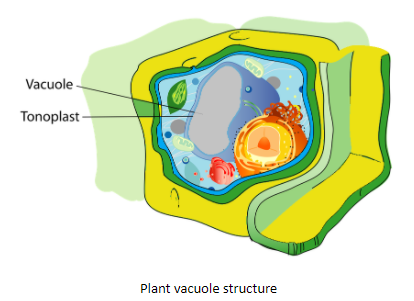
What are the functions of vacuole?
A. Maintaining turgor pressure
B. Containing water
C. Containing waste
D. All of the above
Answer
576.6k+ views
Hint: Vacuoles are the characteristic of plants and occupy a very large space in the cell. These are membrane bound cell organelles which are filled with water, containing inorganic and organic molecules.
Complete answer:
The function of the vacuole is to maintain the turgor pressure. They also contain water and waste.
Functions of vacuole:
- Vacuoles maintain the shape of the cell by creating turgor pressure (internal hydrostatic pressure).
- Vacuoles store pigments that provide color to plant structures such as petals.
- Vacuoles aid in storage of water, food and other substances.
- Vacuoles in some cases contain chemicals which would otherwise react with the cytosol.
- Vacuoles help in maintaining the cytoplasmic pH of the cell in plants.
- Vacuoles are involved in osmoregulation, degradative processes and storing amino acids in certain fungi such as yeast.
- Vacuoles contain gases (gas vacuoles) that help in controlling buoyancy in some cyanobacteria.
- Vacuoles are involved in the containment, transport and disposal of some proteins and lipids to the extracellular environment of the cell in case of animal cells.
So, the correct answer is ‘All of the above’.

Note: - All plant and fungal cells contain vacuoles whereas the vacuoles of animal cells are smaller in size. Most bacteria cells have vacuoles.
- Vacuole is often considered as the largest organelle in the cell.
- A smaller version of a membrane-bound vacuole, many of which can converge to make a vacuole is called a vesicle.
Complete answer:
The function of the vacuole is to maintain the turgor pressure. They also contain water and waste.
Functions of vacuole:
- Vacuoles maintain the shape of the cell by creating turgor pressure (internal hydrostatic pressure).
- Vacuoles store pigments that provide color to plant structures such as petals.
- Vacuoles aid in storage of water, food and other substances.
- Vacuoles in some cases contain chemicals which would otherwise react with the cytosol.
- Vacuoles help in maintaining the cytoplasmic pH of the cell in plants.
- Vacuoles are involved in osmoregulation, degradative processes and storing amino acids in certain fungi such as yeast.
- Vacuoles contain gases (gas vacuoles) that help in controlling buoyancy in some cyanobacteria.
- Vacuoles are involved in the containment, transport and disposal of some proteins and lipids to the extracellular environment of the cell in case of animal cells.
So, the correct answer is ‘All of the above’.

Note: - All plant and fungal cells contain vacuoles whereas the vacuoles of animal cells are smaller in size. Most bacteria cells have vacuoles.
- Vacuole is often considered as the largest organelle in the cell.
- A smaller version of a membrane-bound vacuole, many of which can converge to make a vacuole is called a vesicle.
Recently Updated Pages
Why are manures considered better than fertilizers class 11 biology CBSE

Find the coordinates of the midpoint of the line segment class 11 maths CBSE

Distinguish between static friction limiting friction class 11 physics CBSE

The Chairman of the constituent Assembly was A Jawaharlal class 11 social science CBSE

The first National Commission on Labour NCL submitted class 11 social science CBSE

Number of all subshell of n + l 7 is A 4 B 5 C 6 D class 11 chemistry CBSE

Trending doubts
10 examples of friction in our daily life

One Metric ton is equal to kg A 10000 B 1000 C 100 class 11 physics CBSE

Difference Between Prokaryotic Cells and Eukaryotic Cells

1 Quintal is equal to a 110 kg b 10 kg c 100kg d 1000 class 11 physics CBSE

State the laws of reflection of light

Explain zero factorial class 11 maths CBSE




